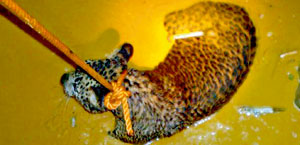The tragic death of a full grown hill country leopard caught in a snare on January 23 was reported in the Sunday Times. Now, come reports of more trouble for wild cats, who could accidentally stray into human settlements.
The most recent leopard incident was reported from Nawalapitiya on February 13. A villager from a Weralugolla, Nawalapitiya who had gone to his well in the morning had been surprised by the sight of a leopard in the well. He promptly informed Nawalapitiya Police and Wildlife officers. After observing the animal for some time the regional wildlife officers had called for more assistance, as the animal had to be tranquilized before it was lifted out to safety.
 |
| The rescue operation gets underway. Pic by Suranga Rajanayake |
This proved to be an uphill task as the animal was exhausted and a large crowd had gathered around the well. The well was about 10 feet deep and the frightened animal had taken refuge in a cavity in the wall of the well. No sooner the leopard was tranquilized, it had fallen unconscious into the water, but the wildlife team had managed to put a rope around its neck and pull it to safety.
“Even four inches of water is enough to drown an unconscious leopard, so we had to act quickly,” explained the veterinarian Dr.Darmakeerthi who had earlier instructed the team to pump the water out of the well. The veterinary surgeon said the leopard was a young male about four and a half feet long, from nose to tail and may have been about one and a half years old.
The village is adjacent to a forest patch known as Rilagala. Leopard experts believe the leopard was a ‘dispersing’ young male, that is an animal on the move in search of a new jungle patch as its territory. When a young leopard matures, it separates from the mother looking for new territories. But the forests are fragmented in many areas forcing them to cross human settlements to reach another jungle patch which results in close encounters with humans.
Rukshan Jayawardene – a leopard conservationist says such infiltrations are more possible during the drought season, adding however, the lack of prey in their natural habitats too could push leopards close to human habitations. When food sources dwindle, the leopards stray into human habitats in search of easier prey, like cattle and dogs in villages. Rukshan Jayawardane also points out the importance of having a common action plan to handle cases of leopards being found in human settlements.
In India the human leopard conflict is worse than in Sri Lanka, but they have developed a plan on what to do when a leopard is spotted in a village, he said, adding that establishing a Task Force to handle Leopard matters under the Wildlife Department here would be helpful to manage the Human Leopard Conflict.
The Nawalapitiya leopard should have ideally been released into the adjacent Rilagala forest, but villagers had protested and wildlife officers were forced to release the animal into the Bomuruella Sanctuary , a closeby hill country habitation.
Experts have pointed out that like in the case of the Human Elephant conflict translocation is not the answer even in the case of the human leopard conflict. Leopard expert Anjali Watson, who studied the Sri Lankan leopard for more than a decade says the leapoard is a territorial predatory animal whose survival depended on knowledge of its habitat, prey species and competitors. Transferring such an animal from one habitat to an alien one resulted in the inability of the animal to adapt to new surroundings.
The Leopard is also a territorial animal which also does not tolerate a stranger in its territory. So if a leopard is relocated into an area where another leopard lives, a battle for supremacy is inevitable, which usually resulted in the death of the relocated animal.
There were several other reports of leopard incidents in the past few weeks. These included finding three leopard cubs in Norwood, the arrest of a Deniyaya planter for trapping and killing a leopard in January. However officials of the Leopard Project of The Wilderness & Wildlife Conservation Trust who investigated these incidents revealed that the animals were fishing cats and not leopard.
The villagers of Norwood had found three young cubs close to a flooding culvert and they were handed over to Norwood police. They were later handed over to the Wildlife Department, but they were too weak to survive. In a similar incident, Rusty Spotted Cat cubs were also handed over by villagers believing that the mother had abandoned the cubs, or being killed by poachers.
However Anjali believes the mother would have been close by and the villagers should have left the cubs where they were. |


